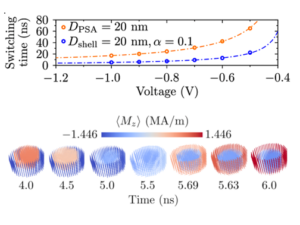We propose the concept of a core-shell composite structure coupled antiparallel via dipolar interaction, as the storage layer in perpendicular-shape-anisotropy magnetic random access memory (PSA MRAM). Benefits compared with a standard PSA MRAM include a reduced write time and the stray field.

CoFeB core with a Co shell (height 8 nm; diameters 14 and 20 nm, respectively). (Top) Decrease of the switching time for the core-shell design compared with a standard PSA; (bottom) Illustration of the sequential switching scheme.
Magnetic Random Access Memories (MRAM) are already on the market, with markets such as cache memory and FPGA/IoT, thanks to their endurance and low power consumption. The storage element of an MRAM is an ultrathin layer with perpendicular magnetization, whose small volume limits the downsize scalability of MRAM to diameter 20 nm or so. To circumvent this limit, the concept of Perpendicular Shape Anisotropy MRAM was proposed and demonstrated independently by Tohoku University and SPINTEC. Its storage layer consists of a short pillar, whose vertical aspect ratio is the main source of perpendicular anisotropy, and the much increased volume allows to sustain thermal stability down to a few nanometers in diameter. However, PSA-MRAM comes with drawbacks, one of them being the difficulty to write due to larger magnetic moment involved, thus requiring a larger write current and longer switching time. Alternative designs are therefore desirable to demonstrate practical applicability.
Here, we introduce the concept of a core-shell composite storage layer coupled via dipolar interactions, which we explore by means of micromagnetic analytics and simulations. We show that a suitable choice of geometry, determining the strength of dipolar coupling and anisotropy energy of the two elements, reduces the write current and switching time with respect to a standard PSA MRAM with identical thermal stability. The underlying mechanism is twofold. First, there is a tendency for sequential reversal, first the core connected to the leads injecting the spin-polarized current, later followed by the shell, which lowers the intermediate energy barrier. Second, a given energy barrier can be attained for shorted cylinders, thereby remaining in the single-domain limit instead of a nucleation-propagation process, the latter being less favorable as the effect of the spin-polarized current is largest at the interface with the tunnel junction than in the bulk of the cylinder.
Our composite approach is similar to the case of coupled multilayers stacked along the vertical direction, explored by Tohoku university. However, it is specific to a three-dimensional object and brings an additional degree of freedom. Besides, the antiparallel coupling ends up in a much reduced or even canceled magnetic moment, providing an efficient mitigation strategy against dipolar cross-talk between neighboring elements, while parallel-coupled stacks do not. This is particularly crucial for PSA, having a large volume and thus magnetic moment, and allow to envision a denser integration. The challenge is now to develop successful fabrication routes and proceed to an experimental realization of this concept.
Teams: Spin textures, MRAM, Theory and Simulations
Funding: Samsung Electronics Co., Ltd. (IO190709-06540-02)
Further reading: Dipole-coupled core-shell perpendicular-shape-anisotropy magnetic tunnel junction with enhanced write speed and reduced crosstalk, N. Caçoilo, L.D. Buda-Prejbeanu, B. Dieny , O. Fruchart, and I.L. Prejbeanu, Phys. Rev. Appl. 21, 044034 (2024). Open access: hal-04335929
Contact: Olivier Fruchart




